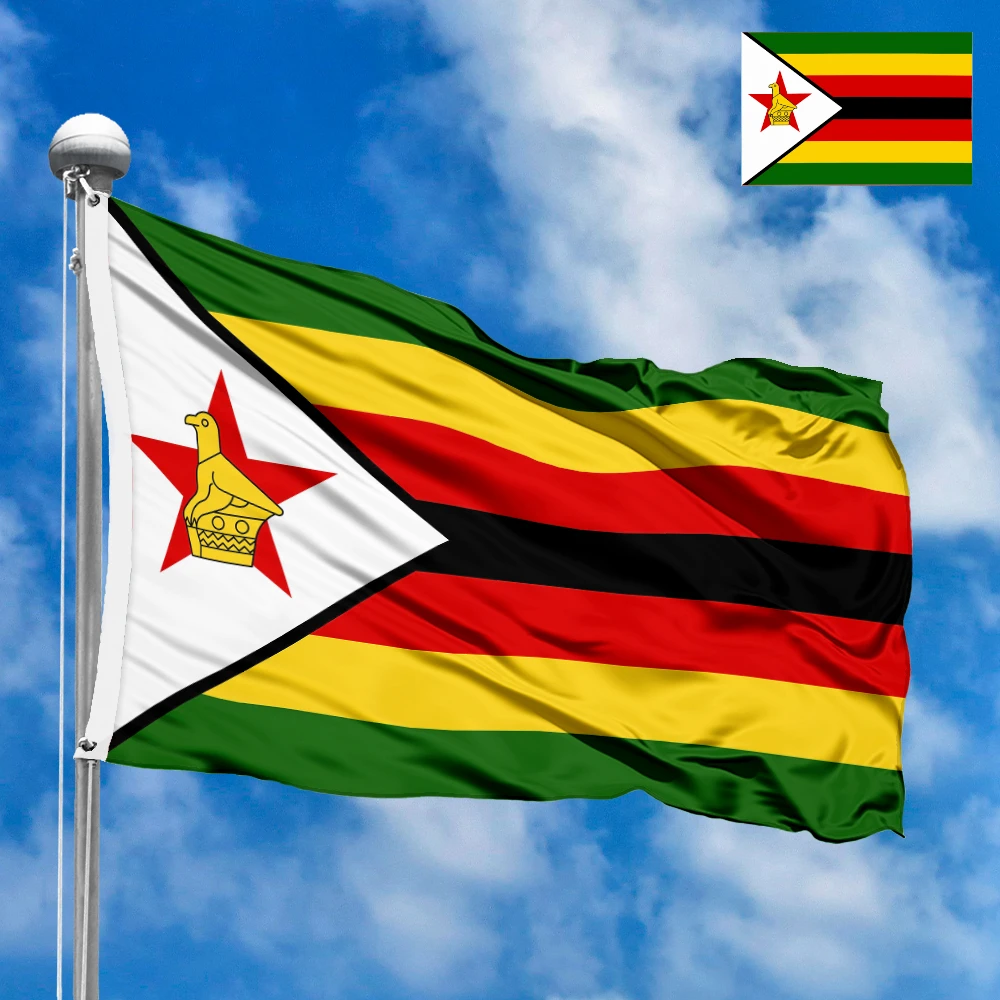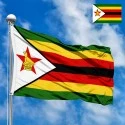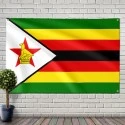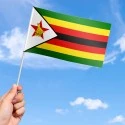Flag of Zimbabwe
- Flag Type: State
- Proportions (official): 1:2
- Official name: Republic of Zimbabwe
- Local name: Zimbabwe
- Sovereignty (year): YES (1980)
- Member of Organizations: UN, African Union
- Country code, territory: ZW, ZWE, 716
- Capital: Harare
- Large cities: Bulawayo, Chitungwiza, Mutare
- Population: ~17,000,000 (2024, UN)
- Religions: Christianity ~85%
- Area (km²): 390 757
- Highest point: Mount Inyangani (2,592 m)
- Lowest point: Confluence of the Rundi and Save Rivers (162 m)
- Currency: Zimbabwe Gold (ZiG)
- Languages: English, Shona, Ndebele, etc.
- Dialing code: +263
- National domain: .zw
Flag Information
General information
Demography and Culture
Economy and communications
- All Flags
- Flags of Countries by Continent
-
Flags of Organizations
- Flags of UN countries
- Flags of the European Union countries
- Flags of NATO countries
- Flags of the countries of the Organization of Islamic Cooperation
- Flags of the countries of the Organization of American States
- Flags of the Arab League countries
- Flags of the African Union countries
- Flags of the countries of the Union of South American Nations
- Flags of the Commonwealth of Nations
- Flags of the countries of the Secretariat of the Pacific Community
- Flags of the Nordic Council countries
- Flags of the Caribbean Community
- Flags of the countries of the Association of Southeast Asian Nations
- Flags of the East African Community
- Flags of the countries of the Organization of Turkic States
- LGBT Community Flags
- Historical Flags
- Ethnic Flags
- Flags of the USA (states)
Description
The national flag of Zimbabwe is a powerful and evocative symbol, deeply intertwined with the nation's tumultuous struggle for independence and its aspirations for a unified, prosperous future. Adopted on April 18, 1980, the day Zimbabwe officially gained its independence from British colonial rule, the flag serves as a vibrant visual testament to the country's rich history, its natural resources, and the sacrifices made by its people. Every element within its design carries profound meaning, reflecting the journey from Rhodesia to Zimbabwe and the hopes of a new era.
Design and Symbolism: A Tapestry of History and Hope
The flag of Zimbabwe features seven horizontal stripes of varying colors, a white triangle at the hoist, and within this triangle, a red five-pointed star behind a yellow Zimbabwe Bird. Each color and symbol is meticulously chosen to represent key aspects of the nation's identity and history:
-
Seven Horizontal Stripes: The stripes across the flag are arranged symmetrically around a central red stripe. From top to bottom, the sequence is green, yellow, red, black, red, yellow, green. This vibrant array of colors carries significant weight:
-
Green (Top and Bottom): The two broad green stripes at the very top and bottom of the flag symbolize the agriculture and rural areas of Zimbabwe. This represents the fertile land, the nation's natural vegetation, and its rich agricultural heritage, which is a cornerstone of the Zimbabwean economy. It signifies the connection of the people to their land and the country's natural wealth.
-
Yellow (Second from Top and Bottom): The two yellow stripes, located beneath the green stripes, represent the mineral wealth of Zimbabwe. Zimbabwe is known for its abundant natural resources, including gold, diamonds, and various other minerals. This color signifies the nation's economic potential and the riches hidden within its earth. It also alludes to the sun and prosperity.
-
Red (Third from Top and Bottom): The two red stripes symbolize the blood shed during the liberation struggle. This is a powerful reminder of the sacrifices, courage, and determination of the Zimbabwean people who fought and died to achieve independence from colonial rule. It honors the martyrs and the long, arduous road to freedom.
-
Black (Central Stripe): The central black stripe is the broadest of all the horizontal bands and represents the black indigenous people of Zimbabwe. It signifies the majority population and their rightful claim to the land. It emphasizes the importance of the black African majority in the independent nation, asserting their identity and sovereignty.
-
-
White Triangle (Hoist Side): The white isosceles triangle at the hoist (left side) of the flag is a crucial element, signifying peace. It represents the desire for a peaceful future, free from conflict and oppression, after the long years of struggle. It also symbolizes the reconciliation and new beginnings that came with independence. Its shape directs attention towards the emblems within it.
-
Red Five-Pointed Star (Within Triangle): Within the white triangle, there is a large, five-pointed red star. This star symbolizes socialism and the revolutionary struggle for a just and equitable society. It represents the hopes and aspirations of the Zimbabwean people for a better, more egalitarian future, inspired by socialist ideals. It's a nod to the political ideology that underpinned the liberation movement.
-
Yellow Zimbabwe Bird (In Front of Star): Superimposed on the red star is a yellow representation of the Great Zimbabwe Bird. This ancient soapstone bird is the most iconic national emblem of Zimbabwe. It is derived from carvings found at the ruins of Great Zimbabwe, a medieval city that was the capital of the Munhumutapa Empire. The bird represents:
-
National Heritage and Ancient History: It links modern Zimbabwe to its rich pre-colonial past, symbolizing the deep roots of indigenous civilization and culture in the region. It is a source of national pride and identity.
-
Continuity and Self-Determination: Its presence on the flag signifies the continuity of the Zimbabwean identity and the nation's right to self-determination, drawing a direct line from ancient African kingdoms to the independent state.
-
Spirit of the Nation: The bird is often seen as a symbol of the national spirit, vigilance, and the protection of the people. Its yellow color reinforces the themes of prosperity and vitality.
-
The collective symbolism creates a narrative: the black majority (black stripe) fought valiantly (red stripes) for their fertile land (green stripes) and mineral wealth (yellow stripes), achieving peace (white triangle) and aspiring to a socialist future (red star), all while upholding their ancient heritage (Zimbabwe Bird).
Dimensions and Proportions:
The official proportions of the Flag of Zimbabwe are a width-to-length ratio of 1:2. This is a common ratio for many national flags, ensuring a balanced and easily reproducible design. The seven horizontal stripes are of equal width. The white triangle at the hoist extends from the top to the bottom edge of the flag, with its apex pointing towards the center of the flag. The red star and the Zimbabwe Bird are positioned centrally within this triangle, ensuring they are prominent features of the flag. Precise specifications for the size and placement of the bird and star are maintained to ensure consistency in flag production.
History and Evolution: From Rhodesia to Zimbabwe
The history of the Zimbabwean flag is a compelling narrative of colonial oppression, liberation struggle, and the birth of a new nation.
-
Colonial Period (Southern Rhodesia): Before 1980, the territory now known as Zimbabwe was a British colony called Southern Rhodesia. Various flags were used during this period, primarily based on British colonial ensigns:
-
British South Africa Company Flag: Initially, the territory was administered by the British South Africa Company (BSAC), which used its own flag, typically a Union Jack with the BSAC badge.
-
Southern Rhodesia Blue Ensign (1923-1964): Upon becoming a self-governing colony in 1923, Southern Rhodesia adopted a blue ensign with the Union Jack in the canton and a badge featuring a pickaxe and lion on a shield.
-
Federation of Rhodesia and Nyasaland (1953-1963): During its brief membership in this federation, a common flag was used, which was a blue ensign with a badge representing the three territories (Southern Rhodesia, Northern Rhodesia, and Nyasaland).
-
Southern Rhodesia Blue Ensign (1964-1968): After the federation dissolved, Southern Rhodesia reverted to a blue ensign, but with a different shield containing the country's coat of arms (featuring the pickaxe and lion).
-
Rhodesian Flag (1968-1979): Following the Unilateral Declaration of Independence (UDI) by Ian Smith's white-minority government in 1965, and its subsequent declaration of a republic, Rhodesia adopted its own distinct flag in 1968. This flag featured three vertical stripes: two green stripes on the outside and a white central stripe, with the Rhodesian coat of arms (often simplified) in the center. This flag was controversial and not recognized internationally.
-
Zimbabwe Rhodesia Flag (1979-1980): A brief transitional period saw the adoption of the Zimbabwe Rhodesia flag, which maintained the Pan-African colors but in a different arrangement, often with a stylized Great Zimbabwe Bird at the hoist. This was part of an attempt to transition to majority rule, but it did not fully satisfy the nationalist movements.
-
-
Birth of Independent Zimbabwe (1980): After years of intense liberation struggle, sanctions, and negotiations (Lancaster House Agreement), Zimbabwe finally achieved full independence on April 18, 1980. On this historic day, the new national flag of Zimbabwe was officially adopted and raised, symbolizing the end of colonial rule and the dawn of a new era. The design of the new flag was a deliberate break from all previous Rhodesian symbols, incorporating colors and emblems that directly represented the liberation movement's ideals and the aspirations of the black majority. It represented a comprehensive redefinition of the nation's identity, rejecting the colonial past and embracing a future built on indigenous heritage and self-determination.
Regional Context and Southern African Identity:
Zimbabwe is a landlocked country located in Southern Africa. Its flag, while uniquely Zimbabwean, incorporates elements that resonate with broader Southern African and Pan-African movements. The use of red, yellow, and green, along with black, are common in the flags of many African nations that gained independence through liberation struggles. These colors often represent similar concepts: green for land/agriculture, yellow for mineral wealth/sun/prosperity, red for blood shed in the struggle, and black for the indigenous people.
However, Zimbabwe's flag stands out with its specific arrangement of seven stripes and, most notably, the inclusion of the Great Zimbabwe Bird and the red star. While the colors connect it to a shared African experience of decolonization, the Zimbabwe Bird firmly roots the flag in its unique historical and cultural heritage, distinguishing it from other flags that might use similar color schemes. The flag thus balances its place within the broader African context with a strong assertion of its distinct national identity, informed by its ancient past and its specific journey to liberation. It is a symbol of a sovereign nation, deeply proud of its heritage and its hard-won freedom, influencing and being influenced by the regional dynamics of southern Africa.
Interesting Facts:
-
Seven-Striped Design: Zimbabwe's flag is one of the few national flags to feature seven horizontal stripes. This specific number is directly related to its design choices and the symmetry around the central black stripe.
-
Unique Bird Emblem: The Great Zimbabwe Bird is a highly distinctive and ancient emblem, making Zimbabwe's flag immediately recognizable and uniquely tied to its pre-colonial history. It's not a common animal or symbol found on other flags.
-
Socialist Symbolism: The red star explicitly represents socialism, reflecting the political ideology of the ZANU-PF liberation movement that came to power at independence.
-
Contrast with Rhodesian Flags: The current flag was a deliberate and stark contrast to the flags used during the Rhodesian era, symbolically erasing the colonial past and embracing a new, indigenous-led future.
-
Pan-African Colors, Zimbabwean Arrangement: While using Pan-African colors (red, yellow, green, black), their specific arrangement and the prominent central black stripe for the people are unique to Zimbabwe.
-
Symbol of Sacrifice and Peace: The red stripes for blood shed and the white triangle for peace together tell a compelling story of achieving peace through struggle.
-
Agricultural and Mineral Wealth: The green and yellow stripes directly highlight Zimbabwe's two primary natural resources and economic pillars: agriculture and minerals.
-
Official Adoption Date: The flag was adopted on April 18, 1980, coinciding with the country's independence day, making its adoption a powerful historical event.
-
Great Zimbabwe Ruins: The Zimbabwe Bird is a replica of soapstone bird sculptures found at the archaeological site of Great Zimbabwe, a UNESCO World Heritage site and a testament to a powerful ancient civilization.
-
National Unity: The entire flag, with its careful balance of elements, aims to symbolize national unity and the coming together of different aspects of Zimbabwean life and history.
Significance for the Inhabitants: A Banner of Identity, Sacrifice, and Aspiration
For the people of Zimbabwe, their national flag is an extraordinarily potent and cherished symbol, a living embodiment of their tumultuous history, their hard-won freedom, and their enduring aspirations. It is not merely a piece of cloth but a vibrant narrative that resonates deeply with their collective memory and national pride.
The vivid colors of the horizontal stripes immediately evoke the fundamental elements of their nation. The green reminds them of the fertile lands that sustain their agricultural economy, a source of livelihood and a connection to their ancestral heritage. The yellow speaks of the rich mineral wealth beneath their feet, a promise of prosperity and a reminder of the nation's potential. Most poignantly, the red stripes serve as a constant, solemn tribute to the immense sacrifices made during the brutal liberation struggle. They honor the blood shed, the lives lost, and the unwavering courage of those who fought to break the chains of colonial oppression. This red is a visceral reminder of the price of freedom and strengthens a sense of collective resilience. The broad central black stripe is perhaps the most direct affirmation of identity for the majority black Zimbabwean population, signifying their rightful place as the indigenous people of the land and the rightful inheritors of the independent nation. It is a powerful statement of self-determination and dignity.
The white triangle at the hoist is a beacon of hope, symbolizing the peace that was so desperately sought and finally achieved after years of conflict. It represents the desire for reconciliation, national healing, and a future free from division. Within this triangle, the red star and the yellow Zimbabwe Bird carry immense weight. The red star, embodying socialist ideals, speaks to the aspirations for a just, equitable, and prosperous society for all. It represents the vision of a Zimbabwe where resources are shared and opportunities are accessible. The iconic Zimbabwe Bird, ancient and majestic, is perhaps the most unifying symbol. It connects every Zimbabwean to their glorious pre-colonial past, to the advanced civilizations that flourished in their land long before the arrival of colonizers. It instills immense pride in their unique cultural heritage, signaling continuity and resilience. It serves as a reminder that their nation has deep historical roots and a strong, unique identity that transcends colonial impositions.
The act of raising this flag on April 18, 1980, was a profoundly emotional and transformative moment, marking the true birth of independent Zimbabwe. For those who lived through the struggle, it was the ultimate vindication of their fight. For younger generations, it is a constant reminder of the sacrifices that paved the way for their freedom and a call to uphold the values it represents. The flag is displayed with immense pride during national holidays, sporting events, and cultural ceremonies, becoming a focal point for collective celebration and remembrance. It is a unifying emblem that transcends tribal and political differences, reminding all Zimbabweans that they are part of one nation, bound by shared history and common aspirations for peace, prosperity, and the continued assertion of their unique heritage on the global stage. It is, in essence, the visual embodiment of their national soul.
In the demonstration images, full-size flags are shown with proportions of 2:3, and hand-held flags with proportions of 1:2.
Donation
Download
Completely free for commercial and non-commercial use (public domain).
You can freely use them in your news magazines, websites, software, mobile applications.
We appreciate a backlink to https://flagssite.com
Raster files - Flag of Zimbabwe (PNG, JPG)
 Waving flag
Waving flag
- PNG format (transparent background), 72dpi, dimensions in Pixels (px), aspect ratio 3:4.
- 15х20 px
- 30х40 px
- 60х80 px
- 120x160 px
- 240x320 px
 Sizes:
Sizes:
"v15" - image size (by height); if necessary, replace with available: v15, v30, v60, v120, v240.
!!! For resizing, use the Latin (eng) keyboard layout.
<img src="https://flagssite.com/flags/v15/20416.png" alt="Flag of Zimbabwe">
 Round flag
Round flag
- PNG format (transparent background), 72dpi, dimensions in Pixels (px), aspect ratio 1:1.
"d15" - image size (diameter); if necessary, replace with available: d15, d30, d60, d120, d240.
!!! For resizing, use the Latin (eng) keyboard layout.
<img src="https://flagssite.com/flags/d15/20416.png" alt="Flag of Zimbabwe">
 Rectangular flag 2:3
Rectangular flag 2:3
- JPG format, 72dpi, dimensions in Pixels (px), aspect ratio 2:3.
"h30" - image size (by height); if necessary, replace with available: h15, h30, h60, h120, h240, h360, h480.
!!! For resizing, use the Latin (eng) keyboard layout.
<img src="https://flagssite.com/flags/h30/20416.jpg" alt="Flag of Zimbabwe">









 Sizes:
Sizes:
 Sizes:
Sizes: